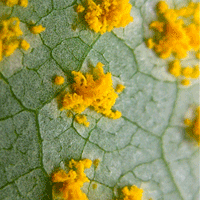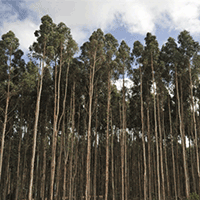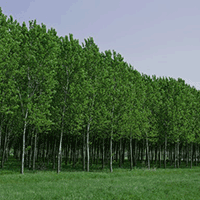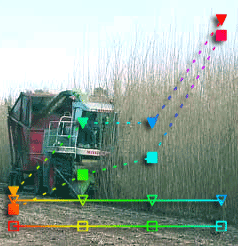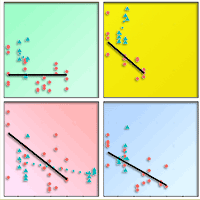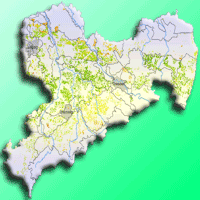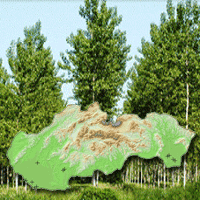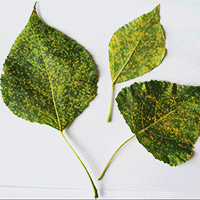
Verification of new Populus nigra L. clone improvement based on their performance over three rotations
Katerina Novotná , Petra Štochlová, Vojtech Benetka
iForest - Biogeosciences and Forestry, Volume 13, Issue 3, Pages 185-193 (2020)
doi: https://doi.org/10.3832/ifor3171-013
Published: May 12, 2020 - Copyright © 2020 SISEF
Research Articles
Abstract
Populus nigra is an important autochthonous woody plant that can be grown as a renewable energy source. The possibility of its improvement through intraspecific hybridization was tested. Differences in biomass production, growth parameters, Melampsora larici-populina rust resistance and drought tolerance were evaluated among 19 intraspecific hybrids from controlled crosses, 2 clones selected from natural populations and the “MAX 4” clone (P. nigra × P. maximowiczii). These P. nigra clones from controlled crosses were chosen from more than 2000 hybrid individuals whose parents were selected from natural populations in the Czech Republic. A field trial was set up in Pruhonice, Czech Republic (320 m a.s.l., 591 mm rainfall annually, mean annual temperature of 9.5 °C). The planting density was 6061 plants ha-1, and the plants were coppiced three times at 3-year intervals. The trial was irrigated only during its establishment. Among the clones, significant differences were found in all the evaluated traits over three rotations. An average dry matter yield of the best clone “MAX 4” was 12.8 t ha-1 yr-1 over three harvests. The best black poplar clone reached up to 9.4 t ha-1 yr-1 in three harvests. Rust resistance was constant over 9 years and high for the three P. nigra clones (two from controlled crosses and one from natural populations). Moreover, the best P. nigra clones from controlled crosses showed higher drought tolerance than the “MAX 4” clone. Breeding progress was confirmed, and most of the P. nigra clones from controlled crosses performed better than the clones selected from natural populations. The trial validated the suitability of natural populations for use as gene sources for intraspecific hybridization and as sources of clones with traits comparable with those of interspecific clones. These new P. nigra clones can replace allochthonous clones in areas where autochthonous P. nigra populations are threatened by introgression.
Keywords
Plant Breeding, Black Poplar, Intraspecific Hybridization, Short Rotation Coppice Culture, Melampsora larici-populina, Biomass Production, Tree Regeneration
Authors’ Info
Authors’ address
Petra Štochlová 0000-0003-3537-4478
Vojtech Benetka
Silva Tarouca Research Institute for Landscape and Ornamental Gardening, Publ. Res. Inst., Kvetnové námestí 391, CZ-252 43 Pruhonice (Czech Republic)
Corresponding author
Paper Info
Citation
Novotná K, Štochlová P, Benetka V (2020). Verification of new Populus nigra L. clone improvement based on their performance over three rotations. iForest 13: 185-193. - doi: 10.3832/ifor3171-013
Academic Editor
Gianfranco Minotta
Paper history
Received: Jun 19, 2019
Accepted: Mar 14, 2020
First online: May 12, 2020
Publication Date: Jun 30, 2020
Publication Time: 1.97 months
Copyright Information
© SISEF - The Italian Society of Silviculture and Forest Ecology 2020
Open Access
This article is distributed under the terms of the Creative Commons Attribution-Non Commercial 4.0 International (https://creativecommons.org/licenses/by-nc/4.0/), which permits unrestricted use, distribution, and reproduction in any medium, provided you give appropriate credit to the original author(s) and the source, provide a link to the Creative Commons license, and indicate if changes were made.
Web Metrics
Breakdown by View Type
Article Usage
Total Article Views: 40193
(from publication date up to now)
Breakdown by View Type
HTML Page Views: 34036
Abstract Page Views: 2819
PDF Downloads: 2569
Citation/Reference Downloads: 3
XML Downloads: 766
Web Metrics
Days since publication: 2065
Overall contacts: 40193
Avg. contacts per week: 136.25
Citation Metrics
Article Citations
Article citations are based on data periodically collected from the Clarivate Web of Science web site
(last update: Mar 2025)
Total number of cites (since 2020): 2
Average cites per year: 0.33
Publication Metrics
by Dimensions ©
Articles citing this article
List of the papers citing this article based on CrossRef Cited-by.
References
Statistické metody [Statistical methods]. Matfyzpress, Prague, Czech Republic, pp. 274. [in Czech].
Gscholar
Exploration of Populus nigra L. genetic variation for partial resistance against the co-adapted pathogen Melampsora larici-populina. In: “International Poplar Symposium (IPS-VI)” (Johnson AM ed). Vancouver (BC, Canada), 20-23 July 2014, pp. 98.
Online | Gscholar
Growing short rotation coppice. Best Practice Guidelines for Applicants to Defra’s Energy Crops Scheme. Department for Environment, Food and Rural Affairs - DEFRA, London, UK, pp. 32.
Gscholar
Characterization of two major genetic factors controlling quantitative resistance to Melampsora larici-populina leaf rust in hybrid poplars: strain specificity, field expression, combined effects, and relationship with a defeated qualitative resistance gene. Phytopathology 94: 1358-1367.
CrossRef | Gscholar
Breeding poplars with durable resistance to Melampsora larici-populina leaf rust: a multidisciplinary approach to understand and delay pathogen adaptation. In: Proceedings of the “4th International Workshop on Genetics of Host-Parasite Interactions in Forestry: Disease and Insect Resistance in Forest Trees” (Sniezko RA, Yanchuk AD, Kliejunas JT, Palmieri KM, Alexander JM, Frankel SJ tech. cords.). Eugene (Oregon, USA), 31 Jul - 5 Aug 2011. General Technical Report PSW-GTR-240, Pacific Southwest Research Station, USDA Forest Service, Albany, CA, USA, pp. 31-38.
CrossRef | Gscholar
Poplars and other fast-growing trees - Renewable resources for future green economies. Synthesis of country progress reports. In: Proceedings of the “25th Session of the International Poplar Commission”. Berlin (Germany) 13-16 Sep 2016. Working Paper IPC/ 15, Forestry Policy and Resources Division, FAO, Rome, Italy, pp. 106.
Gscholar
La protection phytosanitaire du cultivar “Beaupré” - est-elle efficace? [Plant protection of the cultivar “Beaupré” - is it effective?]. Informations Forêt 2, pp. 6. [in French]
Gscholar
Directory of poplar and willow experts. Register of Populus L. cultivars. Instituto di Sperimentazione per la Pioppicultura, Casale Monferrato, FAO, Rome, Italy. [CD-ROM]
Gscholar
Drought tolerance and water-use efficiency of five hybrid poplar clones. In: “Integrated nutrient and water management for sustainable farming” (Currie LD, Singh R eds). Occasional Report No. 29, Fertilizer and Lime Research Centre, Massey University, Palmerston North, New Zealand, pp. 1-13.
Online | Gscholar
Assessing environmental impact of short rotation coppice (SRC) expansion: model definition and preliminary results. Bioenergy Research 5: 621-635.
CrossRef | Gscholar
Cost reduction and efficiency improvement of Short Rotation Coppice. Technical guide, CREFF Final Report Project ERA-Net Bioenergy CREFF, INRA, France, pp. 159.
Online | Gscholar
Deštové faktory CSR [Rain factors of Czechoslovakia]. Státní meteorologický ústav, Prague, Czech Republic, pp. 49. [in Czech]
Gscholar
Productivity, water-use efficiency and tolerance to moderate water deficit correlate in 33 poplar genotypes from a Populus deltoides × Populus trichocarpa F1 progeny. Tree Physiology 29: 1329-1339.
CrossRef | Gscholar
Zpráva o testu drevin na pozemku ve Stachách na Šumave. Prubežná zpráva [Report of the tree testing at the locality Stachy in the Šumava Mountain. Annual report]. Ústrední kontrolní a zkušební ústav zemedelský, Brno, Czech Republic, pp. 16. [in Czech]
Online | Gscholar
Natural hybridisation between Populus nigra L. and P. × canadensis Moench. Hybrid offspring competes for niches along the Rhine river in the Netherlands. Tree Genetics and Genomes 4: 663-675.
CrossRef | Gscholar
Populus breeding: from the classical to the genomic approach. In: “Genetics and Genomics of Populus” (Jansson S, Bhalerao RP, Groover AT eds). Series “Plant Genetics and Genomics: Crops and Models” vol. 8, Springer-Verlag, New York, USA, pp. 309-348.
CrossRef | Gscholar
Breeding poplars resistant to various diseases. In: “Biology of Rust Resistance in Forest Trees” (Bingham RT et al. eds). Miscellaneous Publications no. 1221, USDA Forest Service, Washington, DC, USA, pp. 599-607.
Gscholar
Effect of permanent waterlogging on the growth of poplar clones MAX 4, MAX 5 (J-104, J-105) (Populus maximowiczii A. Henry × P. nigra Linnaeus) and evaluation of wood moisture content in different stem parts - Short Communication. Journal of Forest Science 62: 186-190.
CrossRef | Gscholar
EUFORGEN Technical guidelines for genetic conservation and use for European black poplar (Populus nigra). International Plant Genetic Resources Institute, Rome, Italy, pp. 6.
Gscholar

